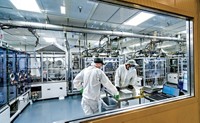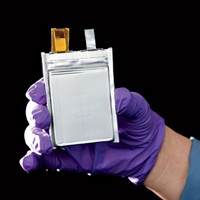Advertisement
Grab your lab coat. Let's get started
Welcome!
Welcome!
Create an account below to get 6 C&EN articles per month, receive newsletters and more - all free.
It seems this is your first time logging in online. Please enter the following information to continue.
As an ACS member you automatically get access to this site. All we need is few more details to create your reading experience.
Not you? Sign in with a different account.
Not you? Sign in with a different account.
ERROR 1
ERROR 1
ERROR 2
ERROR 2
ERROR 2
ERROR 2
ERROR 2
Password and Confirm password must match.
If you have an ACS member number, please enter it here so we can link this account to your membership. (optional)
ERROR 2
ACS values your privacy. By submitting your information, you are gaining access to C&EN and subscribing to our weekly newsletter. We use the information you provide to make your reading experience better, and we will never sell your data to third party members.
Energy
ARPA-E Shows Off Its Big Batteries
Shifting to a low-carbon energy grid calls for new chemistry for stationary storage
by Melody M. Bomgardner
March 16, 2015
| A version of this story appeared in
Volume 93, Issue 11
When the chief executive officer of a large solar power firm took the stage at a conference about new energy technologies last month, the audience was not surprised to hear him hail the affordability of solar. But when the CEO, SunEdison’s Ahmad R. Chatila, talked about his firm’s future investments, the crowd took notice. “The most important technology is storage,” he said.
The U.S. needs energy storage to enable a reliable infrastructure that can efficiently use renewable energy, emphasized speakers at the Department of Energy’s Advanced Research Projects Agency-Energy Summit, a gathering of scientists, businesspeople, and government employees that took place just outside Washington, D.C. ARPA-E funds researchers and start-ups to develop early-stage energy innovations and find a path to market.
Out of the lab
ARPA-E helped an energy storage technology, developed at MIT, select a target market for its large-scale liquid metal batteries. Now a spin-off firm, AMBRI is producing prototypes for customers.
Source: Credit: ARPA-E.
Chatila was preceded on ARPA-E’s main stage by the agency’s new director, Ellen Williams. Trained as a chemist, Williams was formerly chief scientist at BP. Though she referred to herself as a “true geek,” she emphasized that the agency’s strength is its “unblinking understanding of the market so that we can identify where a small, focused investment can have a big impact.”
Power plants based on coal or gas make energy on demand; renewable energy plants based on the wind or sun aren’t so reliable. Better batteries for storing that energy could help supply renewable energy around the clock, make electric grids operate efficiently, and even displace so-called peak power plants that run intermittently (see page 24).
One way companies have stored energy is as heat in molten salts. Today, lithium-ion batteries similar to those that run laptops and mobile phones are becoming more dominant. But large Li-ion systems have drawbacks. They are expensive, they can’t supply power for longer than two to four hours at a stretch, and they have a limited life span. ARPA-E is backing a host of alternative chemistries that might address these limitations.

For example, one early ARPA-E awardee says it has developed a low-cost, large-scale battery that can last upward of 15 years. In early 2010, the lab of Massachusetts Institute of Technology materials science professor Donald R. Sadoway received $7 million to develop a “community-scale” storage technology that uses floating layers of liquid magnesium and antimony that function as electrodes and electrolyte.
The funds allowed the team to fine-tune its chemistry and form a company, now called Ambri, that has raised additional funds from Bill Gates, venture capitalist Vinod Khosla, and French oil firm Total. Ambri CEO Phil Giudice said the start-up’s proprietary materials have been tested over thousands of charging cycles and can provide power for many hours.
Now a 46-person company, Ambri is busy building six large prototypes that will be tested by power providers in Connecticut, New York, Hawaii, and Alaska and at a military base in Massachusetts. It has its first commercial order, for a 1-MW system to be delivered at the end of 2016. At this point, it must make decisions about its manufacturing strategy. “We need to put together a supply chain and not be dependent on any one company,” Giudice said.
Manufacturing concerns are still in the future for Richard Wirz, director of the Energy Innovation Laboratory at the University of California, Los Angeles. His team received ARPA-E funding through 2016 for a new battery chemistry that will store excess energy from solar thermal plants—which collect the sun’s energy using mirrors—to enable power production at night.
“The bad way to do this is to come up with the perfect fluid and then try to reduce the cost,” Wirz said. “So we worked to find cheap fluids first.” Wirz’s team has identified a liquid that has a low vapor pressure, similar to molten salts, but is much cheaper. It stores power in three ways: as heat, through phase change, and via thermochemistry.
You don’t have to be a professor at a big research institution to attract ARPA-E funds. Craig Evans, CEO of Energy Storage Systems (ESS), left his job as a fuel-cell engineer to build iron flow batteries in his garage. The company received $2 million from ARPA-E in 2012 for a prototype. “I put my fuel-cell background to use for the cell design—I could go for low cost and I knew what not to do,” Evans explained. ESS has supplied batteries to vineyards in California and to the U.S. Army Corps of Engineers for testing.
Flow batteries store energy in two electrolytes kept in separate tanks and pumped into a battery cell. When they meet on either side of a membrane, they exchange ions, creating an electric current. Evans says his iron chemistry provides flow batteries that are less expensive than ones based on vanadium and last longer than Li-ion batteries.
ARPA-E funding doesn’t just help small technology firms move out of the garage, it helps them attract private investors. Colin Wessells was actually living in a garage in high-rent Palo Alto, Calif., when he decided to make a business from his Ph.D. thesis. He got ARPA-E backing in 2013. His firm, Alveo Energy, has since attracted an investment from Khosla Ventures.
Alveo has another year to go as an ARPA-E grantee for its low-cost technology, a battery that uses electrodes based on Prussian blue dye and a water-based, nonflammable sodium electrolyte. “We’re building cells by hand now, but post-ARPA-E we hope to get more funding to make prototypes,” Wessells said.




Join the conversation
Contact the reporter
Submit a Letter to the Editor for publication
Engage with us on Twitter